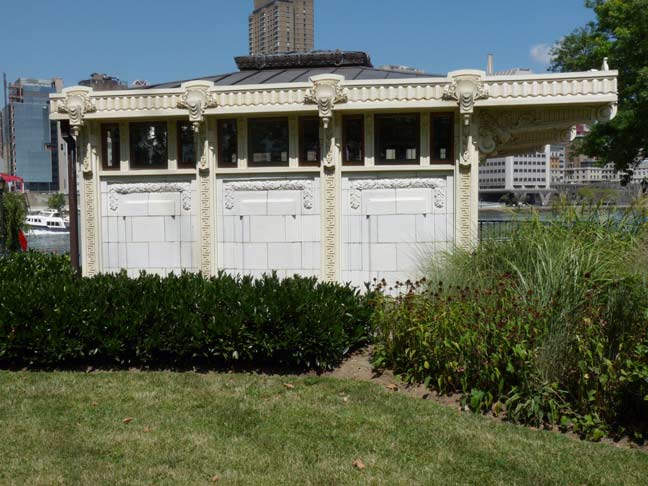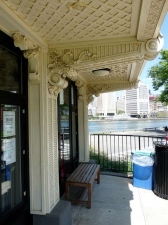Even though Manhattan is an island, Roosevelt Island is an island in the borough of Manhattan. I was slouching around the southern end of the island this past week, as I’m fascinated with the NYC talismanic objects that somehow have accreted around the tramway landing area just north of the subway exit. This part of the island has undergone peculiar dynamism of late, as new residential towers have opened and more are currently being built. The new Southpoint Park has been landscaped around some old buildings and ruins, and it was my intention to scope out the new Four Freedoms memorial and its remembrance of Franklin Delano Roosevelt, for whom the island was renamed in the mid-1970s.
In addition, the Goldwater campus of the Coler-Goldwater Hospital is being demolished to make way for a new Cornell University Graduate School of Technology. The Bird S. Coler Hospital on the northern end of the island is now the last remaining of Roosevelt Island’s collection of mental hospitals and facilities treating infectious diseases.
I was stymied because today was Tuesday and a number of things on Roosevelt Island close on Tuesday. Who would have guessed?

One of my particular quarries today was one of what was originally five exquisite entrance and exit kiosks, rendered in beautiful Beaux Arts terra cotta, that used to stand at 2nd Avenue and East 60th Street where trolleys from Queens let out, or accepted passengers from an underground station.
One of the kiosks, now the Roosevelt Island Visitor Center, is dwarfed by the Queensboro/59th Street/Ed Koch Bridge, as well as one of the huge stanchions that carry the tramway wires.
The bridge was one of the last bastions of trolley traffic in Manhattan, as the line that left people of midspan, to be carried by elevator to the island, was among the last to be shuttered in the late 1950s.
Both kiosks, this one and one that has been allowed to remain on 2nd Avenue, go all the way back to the year the Queensboro opened in 1909. Trolley service to the bridge ended in 1957 when the Welfare Island, now Roosevelt Island Bridge opened to Astoria.

Thus the five Beaux Arts kioks were orphaned. Three were executed, one remained in place, and one was shuffled off in 1970 to the Brooklyn Children’s Museum in Bedford-Stuyvesant’s Brower Park, where it was used as the main entrance. However it was in danger of being discarded when the Museum planned a complete renovation by famed architect Rafael Viñoly.

However, at the intercession of the Roosevelt Island Historical Society’s Judy Berdy, who worked with the BCM and several other agencies, in 2006 the kiosk was transported here to the very spot where the trolley elevator landing was once located, where it now serves as the Roosevelt Island Historical Society‘s visitor center…
…except on Tuesdays, when it’s closed.
8/21/14




13 comments
Some of us still call it Welfare Island cuz thats what we’re used to calling it.
Which must bug the hell out of people that live there.
I agree, Chris. It will always be Welfare Island to us. I remember traveling the trolley with my Mother, to the middle of the Bridge. But I don’t remember coming down the elevator from there.
2 Questions:
1) Do any parts of the trolley terminals remain? Whether they do or not, it would be great to see photos of what they used to look like.
2) Is the trolley elevator landing the same as the “Upsidedown Building” where patients arrived via ambulance to go to the various hospitals?
– Jeff
PS: Had to look up accreted. Thanks for the vocab lesson.
Until 1957, when the Welfare Island Bridge opened, the only vehicular access to the island was via the elevator in the “Upsidedown Building”. That included emergency vehicles, like police and fire. With the increasing size of fire trucks, that posed a problem of fitting newer, longer units into the old elevator to bring them down from the Queensboro Bridge roadway. Long ago, an old-timer with the FDNY told me that they squeezed some fire trucks onto the elevator by removing the front and rear bumpers when there was an emergency call from the Island. The firehouses for these specific units kept wrenches at the ready and could remove the bumpers at at moment’s notice before they raced to the Bridge and the elevator!
Renaming Welfare Island Roosevelt Island was the epitome of irony. FDR’s legacy was the welfare state. FDR is long gone but the welfare state continues despite it’s toxicity. A monument to the so called 4 Freedoms is another invitation to worship at the altar of the golden calf. The truth is: only Jesus saves.
typical response from lowlife right wing scum.Besides Jesus loved the poor .
The Era of BO will soon end. Will you be joining ISIS?
I believe the Queensboro Bridge trolley was the last to operate in New York State, it outlasted the last Brooklyn lines by a couple of years.
Wouldn’t the tramway landing area be south of the subway exit? The subway is the 63rd St. tunnel, the tramway is at 60th St.
Dan, you are correct. The tram is about 2 blocks (an estimate because there are no cross streets) south of the subway.
To nit pick:
The Brooklyn Children’s Museum is in CROWN HEIGHTS on Brooklyn Avenue not Bedford-Stuyvesant! Informative piece, though.
I believe the terminals on the Manhattan end are used for DOT storage. The entrance from the bridge ramp to the terminal used to be closed off by a fence, and you could see storage inside.
Hi, after reading this awesome paragraph i am too delighted to share my knowledge here with mates.